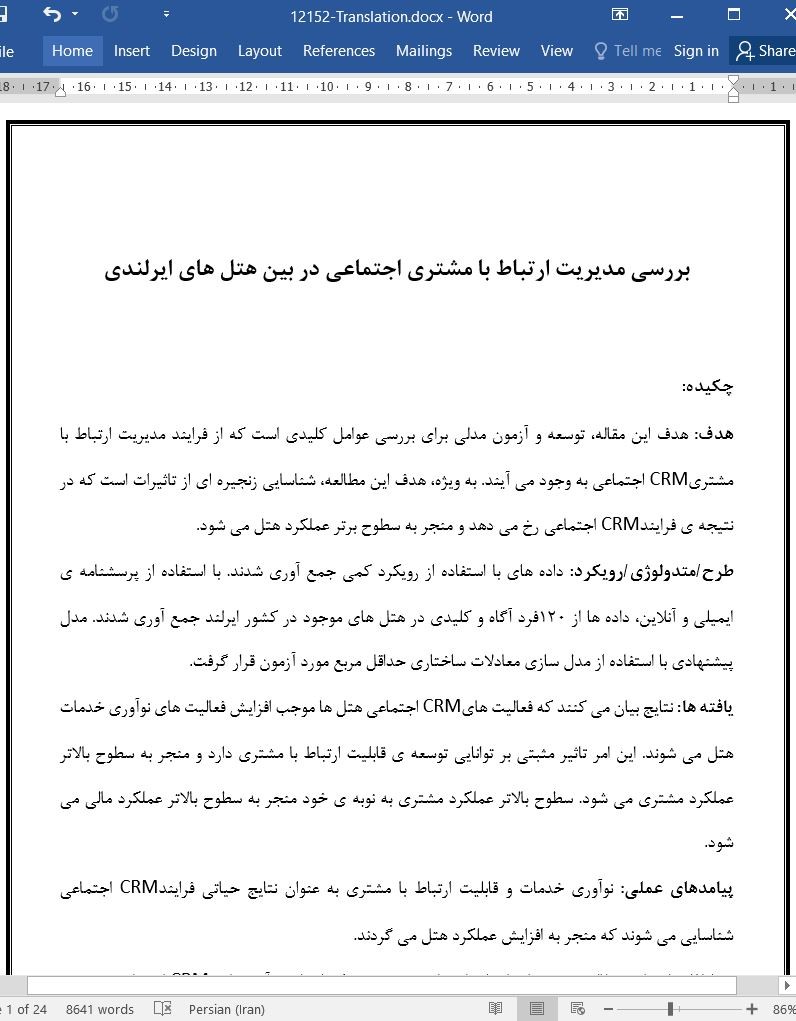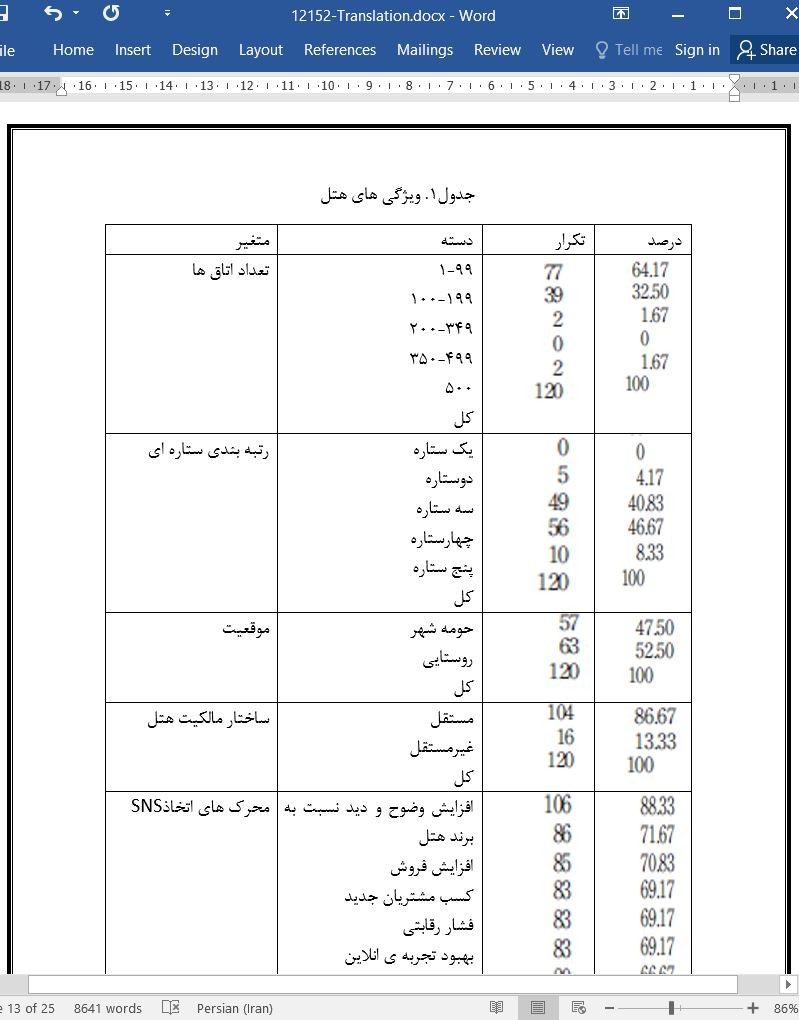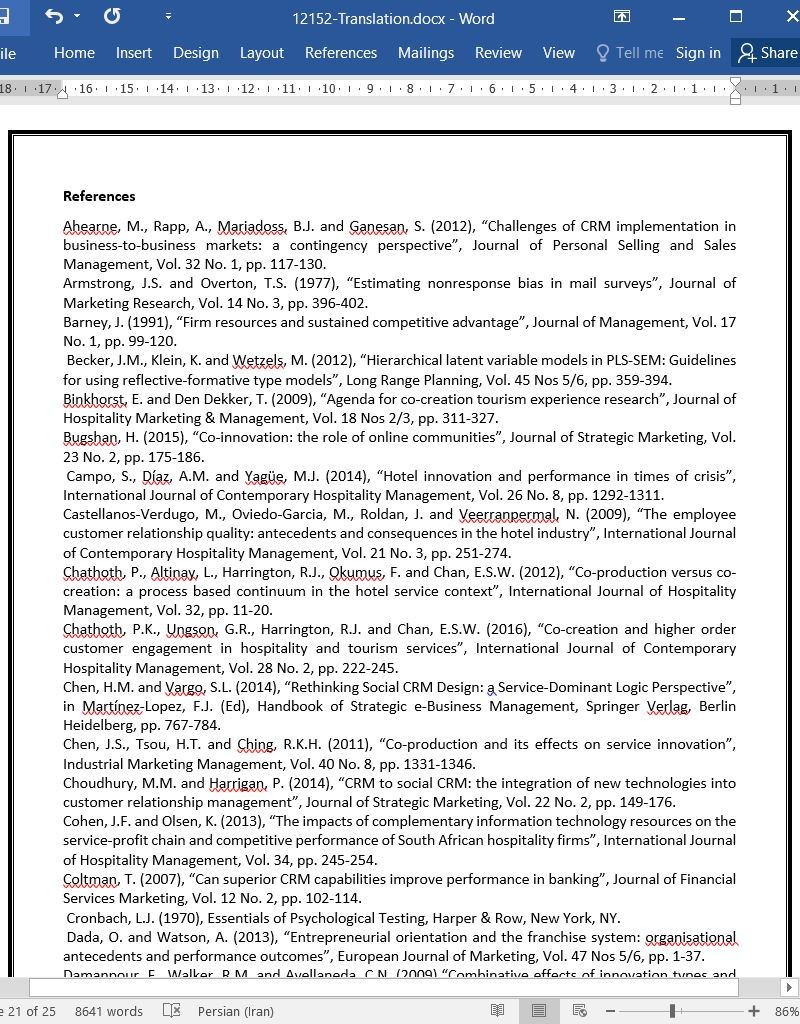
بررسی مدیریت ارتباط با مشتری اجتماعی در بین هتل های ایرلندی
چکیده
هدف: هدف این مقاله، توسعه و آزمون مدلی برای بررسی عوامل کلیدی است که از فرایند مدیریت ارتباط با مشتریCRM اجتماعی به وجود می آیند. به ویژه، هدف این مطالعه، شناسایی زنجیره ای از تاثیرات است که در نتیجه ی فرایندCRM اجتماعی رخ می دهد و منجر به سطوح برتر عملکرد هتل می شود.
طرح/متدولوژی/رویکرد: داده های با استفاده از رویکرد کمی جمع آوری شدند. با استفاده از پرسشنامه ی ایمیلی و آنلاین، داده ها از 120فرد آگاه و کلیدی در هتل های موجود در کشور ایرلند جمع آوری شدند. مدل پیشنهادی با استفاده از مدل سازی معادلات ساختاری حداقل مربع مورد آزمون قرار گرفت.
یافته ها: نتایج بیان می کنند که فعالیت هایCRM اجتماعی هتل ها موجب افزایش فعالیت های نوآوری خدمات هتل می شوند. این امر تاثیر مثبتی بر توانایی توسعه ی قابلیت ارتباط با مشتری دارد و منجر به سطوح بالاتر عملکرد مشتری می شود. سطوح بالاتر عملکرد مشتری به نوبه ی خود منجر به سطوح بالاتر عملکرد مالی می شود.
پیامدهای عملی: نوآوری خدمات و قابلیت ارتباط با مشتری به عنوان نتایج حیاتی فرایندCRM اجتماعی شناسایی می شوند که منجر به افزایش عملکرد هتل می گردند.
منشا/ارزش: این مطالعه زنجیره ای از تاثیرات را شرح می دهد که از طریق آن، فرایندCRM اجتماعی منجر به سطوح بالاتر عملکرد می شود.
1.مقدمه
علی رغم ارائه ی ضرورت استراتژیک در صنعت هتل(مالندز و مورنو2014 رحیمی2017)، چندین هتل، شکست در مدیریت ارتباط با مشتریCRM را تجربه کرده اند(رحیمی و گونلو2016). در حالی که پژوهش قبلی چندین دلیل را برای شکست فناوری های سنتیCRM بیان کرده است(ترینر2012)، پژوهش نوظهورCRM، نقش فناوری های اجتماعی را در تحقق موفقیت مورد بررسی قرار می دهد.
گسترش رسانه ی اجتماعی دارای پیامدهای مهم برای صنعت هتلداری است. رسانه ی اجتماعی منجر به مشتریان توانمند و دارای اطلاعات غنی در اکوسیستم ایجاد ارزش می شود(هنیگ و توراو2010). رسانه ی اجتماعی، منبع ارزشمندی برای تجارب گردشگران است، آن ها می توانند تجارب کیفی خود و رضایت و عدم رضایت خود از مقصد مورد نظر را با ویژگی های ملموس نشان دهند(گونزالز و رودریگز2016). این محتوای کاربرپسند می تواند تاثیر قابل توجهی بر تصمیمات گردشگری سایر مشتریان داشته باشد(ویجلیا2016). به طور خلاصه، سایت های شبکه های اجتماعیSNS دارای تاثیر انتقالی در صنعت هتلداری هستند. ان ها روشی را ارائه می دهند که مشتریان می توانند اطلاعات مورد نظر در فرایند تصمیم گیری خرید را جمع آوری نمایند(چنگ2016).
Abstract
Purpose The purpose of this paper is to develop and test a model examining the key factors that emerge from the social customer relationship management (CRM) process. Specifically, this study aims to address the chain-of-effects that occurs as a result of the social CRM process, leading to superior levels of hotel performance.
Design/methodology/approach Data were collected using a quantitative approach. Using a mail and online questionnaire, data were gathered from 120 key informants in hotels in Ireland. The proposed model was tested using partial least squares structural equation modelling.
Findings Results demonstrate that the social CRM activities of hotels enhance hotel service innovation activities. This positively impacts the ability to develop a customer-linking capability, resulting in higher levels of customer performance. In turn, higher levels of customer performance leads to higher levels of financial performance.
Practical implications Service innovation and customer-linking capability are identified as critical outcomes of the social CRM process that lead to enhanced hotel performance.
Originality/value This study explains the chain-of-effects through which the social CRM process results in higher levels of performance.
1. Introduction
Despite representing a strategic imperative in the hotel industry (Padilla-Meléndez and Garrido-Moreno, 2014; Rahimi, 2017), several hotels have experienced customer relationship management (CRM) failures (Rahimi and Gunlu, 2016). Whereas previous research has documented several reasons for the failure of traditional CRM technologies (Jayachandran et al., 2005; Trainor, 2012), nascent CRM research is investigating the role of social technologies in achieving success.
The proliferation of social media has important implications for the hospitality industry. Social media has led to information-rich and empowered customers within a value cocreation ecosystem (Hennig-Thurau et al., 2010). “Social media have become a valuable resource for tourists’ experiences, where they can explicitly show their qualitative experience as well as their satisfaction/dissatisfaction with tangible attributes concerning a destination” (González-Rodríguez et al., 2016, pp. 19-20). This user-generated content can significantly influence the travel decisions of other customers (Viglia et al., 2016). In short, social networking sites (SNSs) are having a transformative effect in the hospitality industry. They are altering and inverting the manner in which customers collect information in the purchase decision-making process (Li and Chang, 2016).
چکیده
1.مقدمه
2.چار چوب نظری و فرضیات پژوهش
2.1 مدیریت ارتباط با مشتری اجتماعی
2.2 تاثیر مدیریت ارتباط مشتری اجتماعی نوآوری خدمات
2.3 تاثیر نو آوری خدمات بر قابلیت ارتباط مشتری
2.4 تاثیر قابلیت ارتباط با مشتری بر عملکرد مشتری
2.5 تاثیر قابلیت ارتباط با مشتری ب عملکرد مالی
2.6 تاثیر عملکرد مشتری بر عملکرد مالی
3.متدولوژِی
3.1 نمونه وروند (رویه)
3.2 معیارها
4. تجزیه وتحلیل داده ها ونتایج
4.1 تجزیه وتحلیل داده ها
4.2 مدل ارزیابی
4.3 مدل ساختاری
5. بحث ونتایج
5.1 نتایج
5.2 پیامدهای نظری
5.3 پیامدهای عملی
5.4 محدودیت ها و پژوهش آینده
منابع
Abstract
1. Introduction
2. Theoretical framework and research hypotheses
2.1 Social customer relationship management
2.2 The influence of social customer relationship management on service innovation
2.3 The influence of service innovation on customer-linking capability
2.4 The influence of customer-linking capability on customer performance
2.5 The influence of customer-linking capability on financial performance
2.6 The influence of customer performance on financial performance
3. Methodology
3.1 Sample and procedure
3.2 Measures
4. Data analysis and results
4.1 Data analysis
4.2 Measurement model
4.3 Structural model
5. Discussion and conclusions
5.1 Conclusions
5.2 Theoretical implications
5.3 Practical implications
5.4 Limitations and future research
References
- اصل مقاله انگلیسی با فرمت ورد (word) با قابلیت ویرایش
- ترجمه فارسی مقاله با فرمت ورد (word) با قابلیت ویرایش، بدون آرم سایت ای ترجمه
- ترجمه فارسی مقاله با فرمت pdf، بدون آرم سایت ای ترجمه



